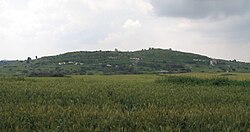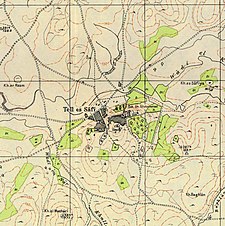Tell es-Safi
تلّ الصافي Tel Tzafit | |
|---|---|
 | |
A series of historical maps of the area around Tell es-Safi (click the buttons) | |
Location within Israel | |
| Coordinates: 31°42′15″N 34°50′49″E / 31.70417°N 34.84694°E | |
| Palestine grid | 135/123 |
| Geopolitical entity | Israel |
| Subdistrict | Hebron |
| Date of depopulation | 9–10 July 1948[3] |
| Area | |
| • Total | 27,794 dunams (27.794 km2 or 10.731 sq mi) |
| Population (1945) | |
| • Total | 1,290[1][2] |
| Cause(s) of depopulation | Military assault by Yishuv forces |
Tell es-Safi (Arabic: تل الصافي, romanized: Tall aṣ-Ṣāfī, "White hill"; Hebrew: תל צפית, Tel Tzafit) was an Arab Palestinian village, located on the southern banks of Wadi 'Ajjur, 35 kilometers (22 mi) northwest of Hebron which had its Arab population expelled during the 1948 Arab–Israeli war on orders of Shimon Avidan, commander of the Givati Brigade.[4]
Archaeological excavations show that the site (a tell or archaeological mound) was continuously inhabited since the 5th millennium BCE.[5] It appears on the Madaba Map as Saphitha, while the Crusaders called it Blanche Garde.[6][7] It is mentioned by Arab geographers in the 13th and 16th centuries. Under the Ottoman Empire, it was part of the district of Gaza. In modern times, the houses were built of sun-dried brick. The villagers were Muslim and cultivated cereals and orchards.
Today the site, known as Tel Tzafit, is an Israeli national park incorporating archaeological remains which some have identified as the Philistine city of Gath, mentioned in the Bible.[8] The remains of the Crusader fort and the Arab village can also be seen on the tell.[5]
- ^ a b Government of Palestine, Department of Statistics. Village Statistics, April, 1945. Quoted in Hadawi, 1970, p. 50
- ^ Department of Statistics, 1945, p. 23
- ^ Morris, 2004, p. xix, village number #292. Also gives cause of depopulation
- ^ Morris, 2004, p. 436
- ^ a b Cite error: The named reference
Negevp445was invoked but never defined (see the help page). - ^ Kallai-Kleinmann (1958), p. 155
- ^ Tsafrir (1994), p. 134
- ^ Hastings and Driver, 2004, p. 114




